Sir John Monash, Personal Files Book 13, 1 July - 16 August 1916, Part 7
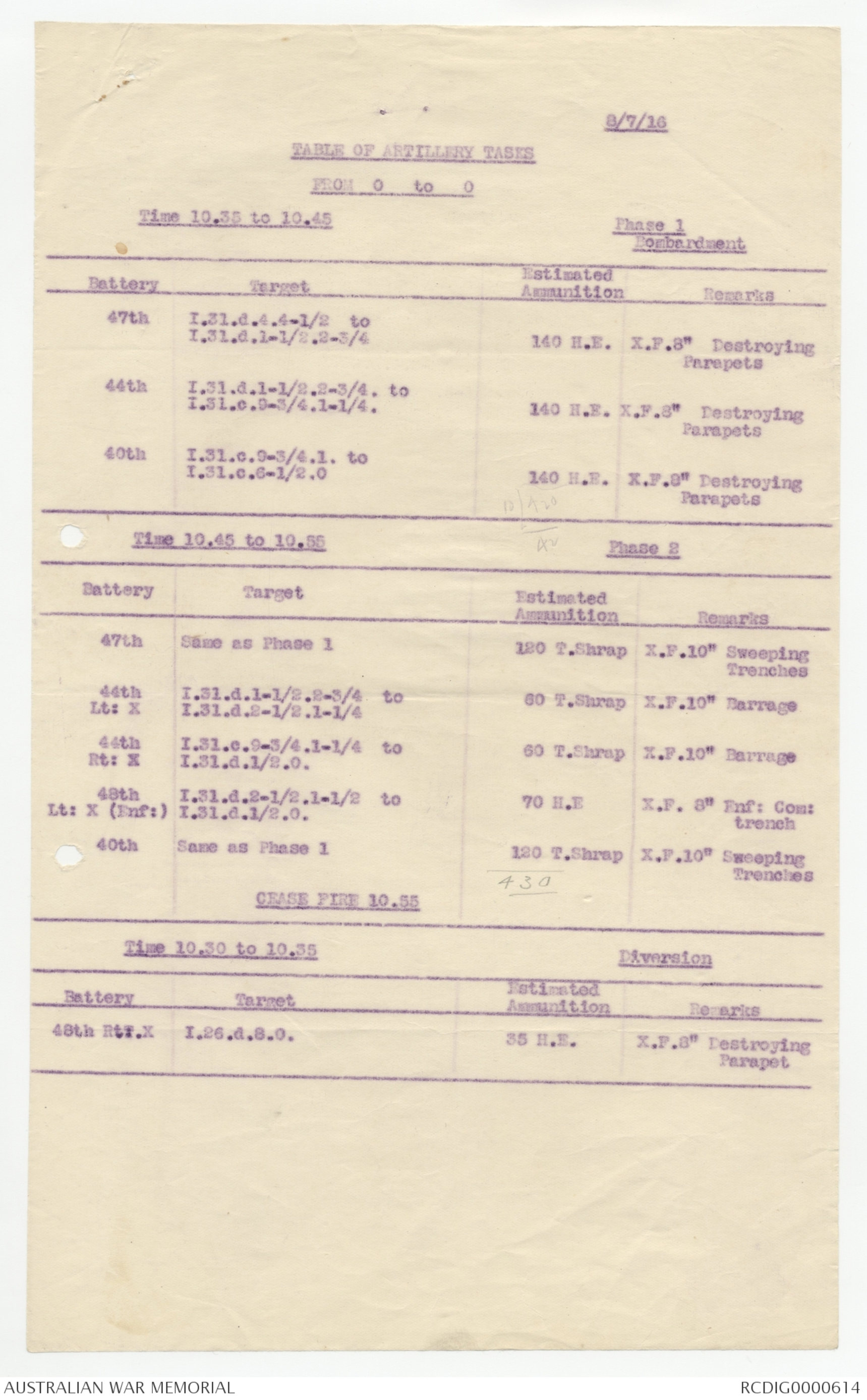
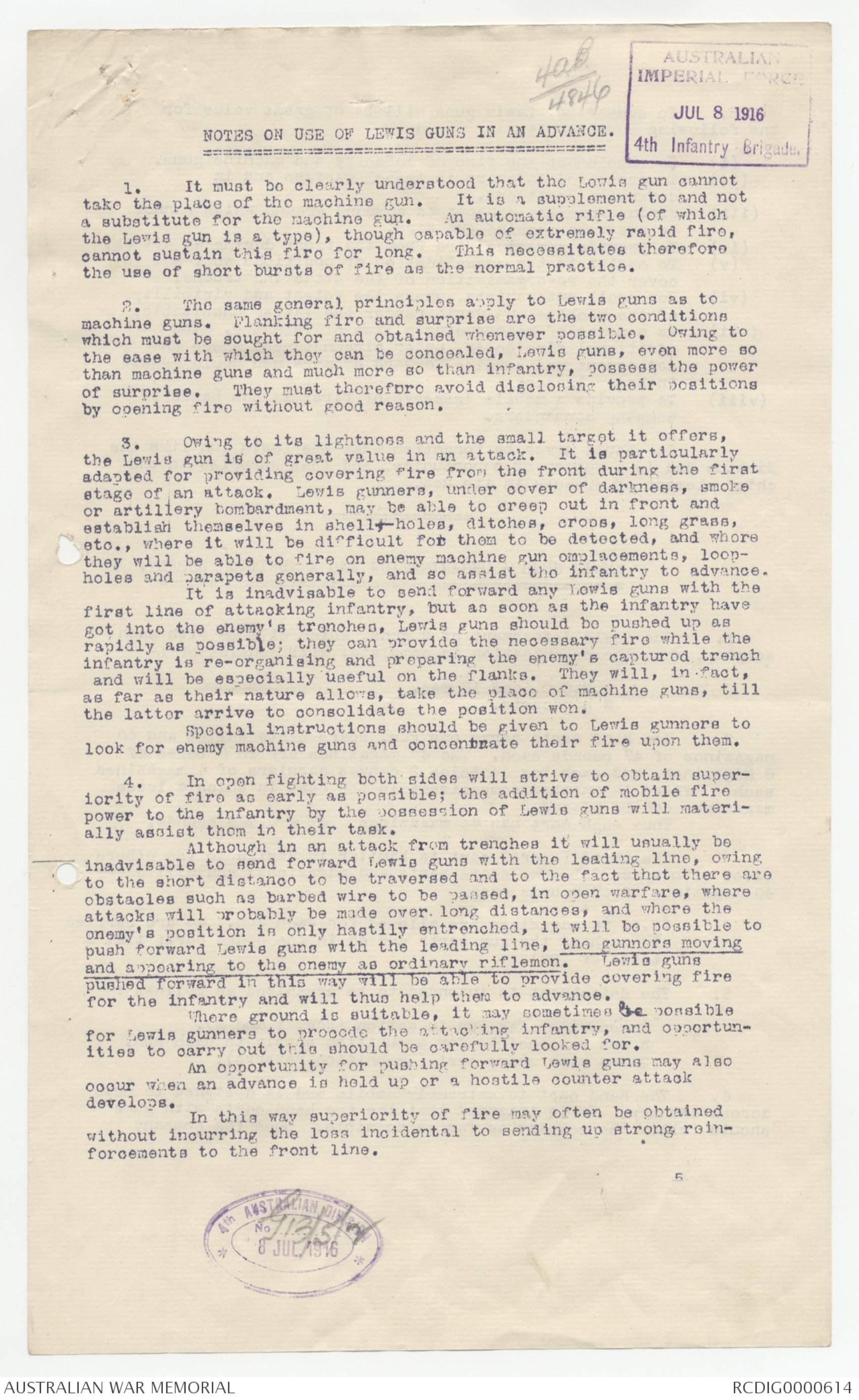
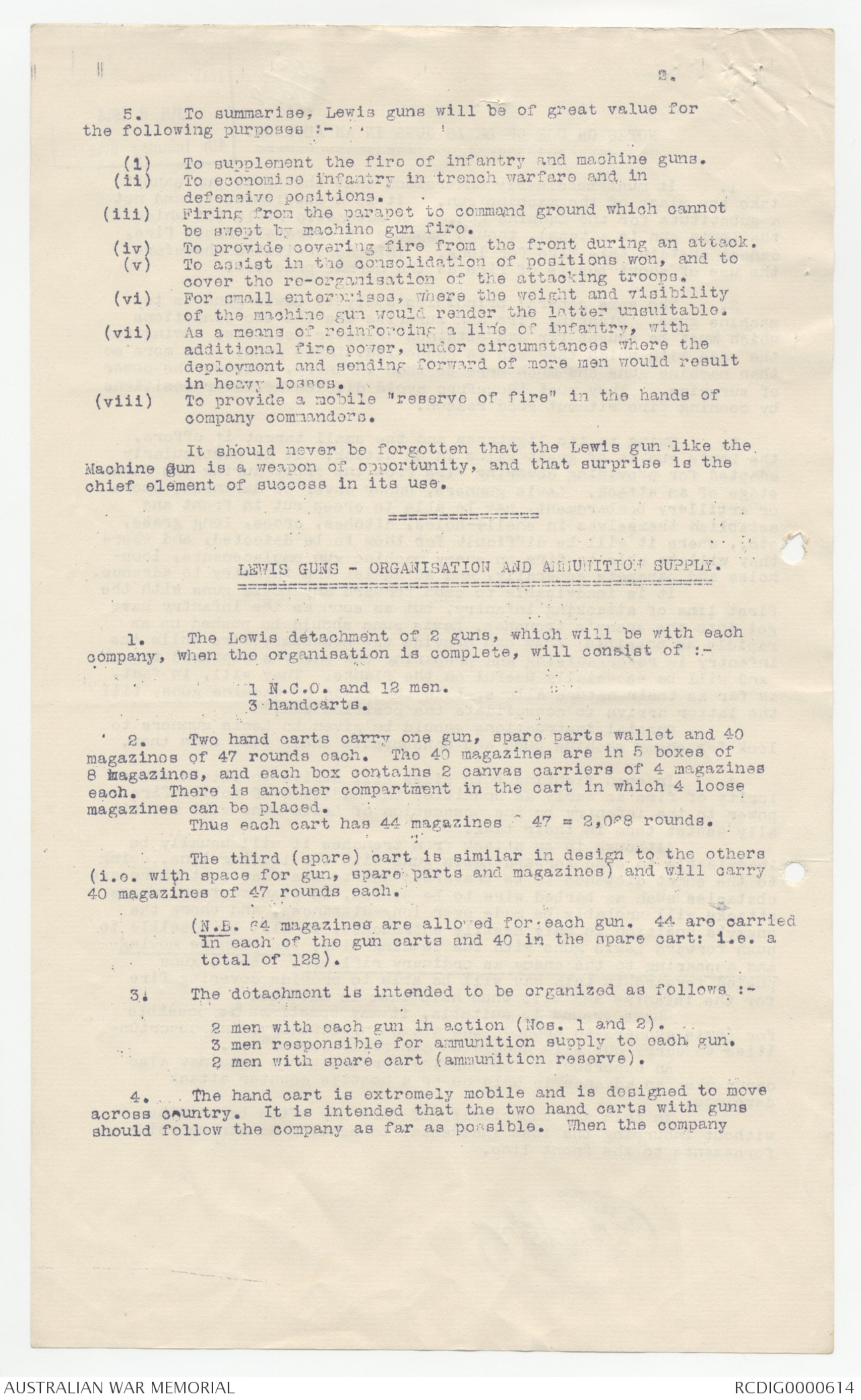
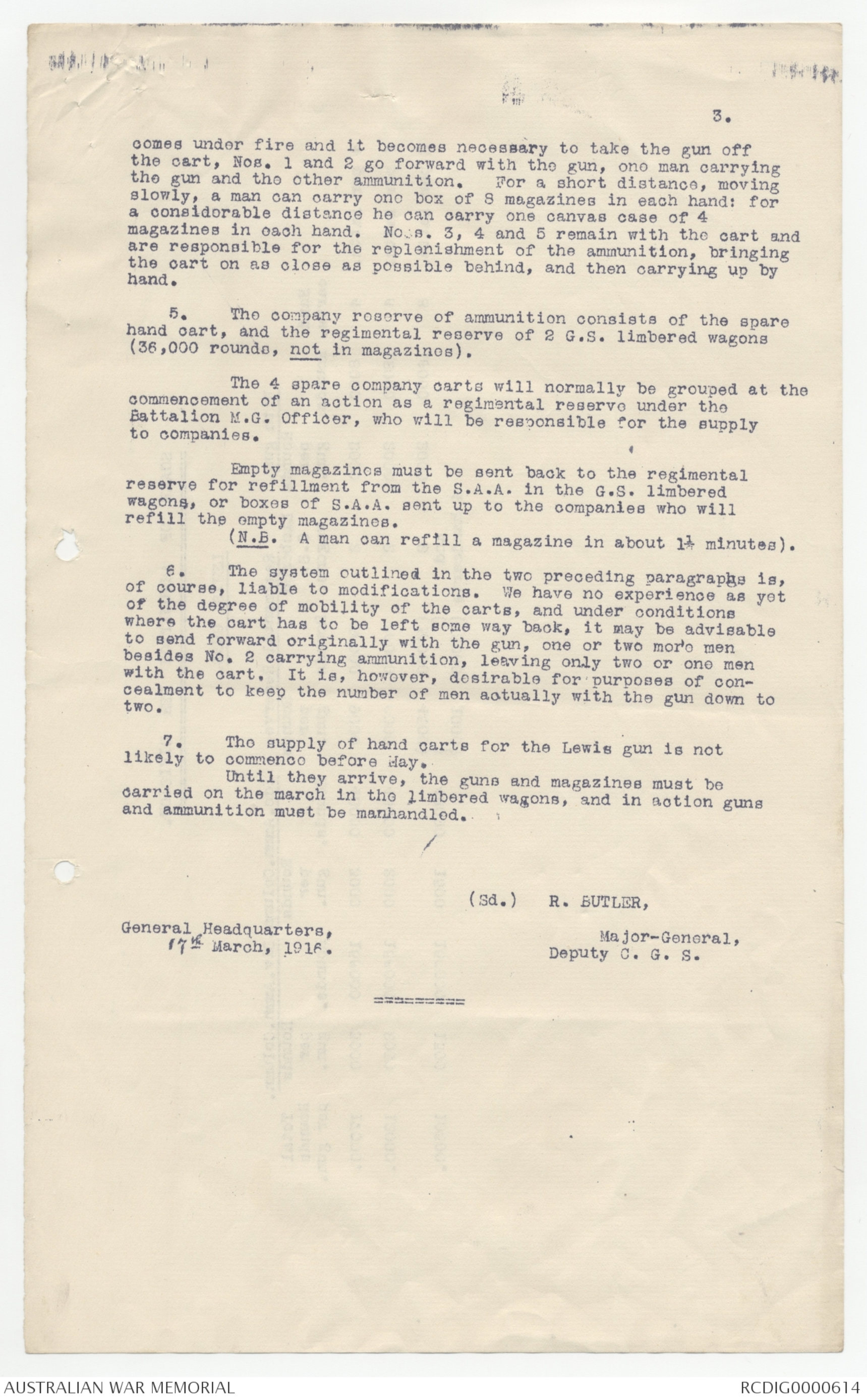
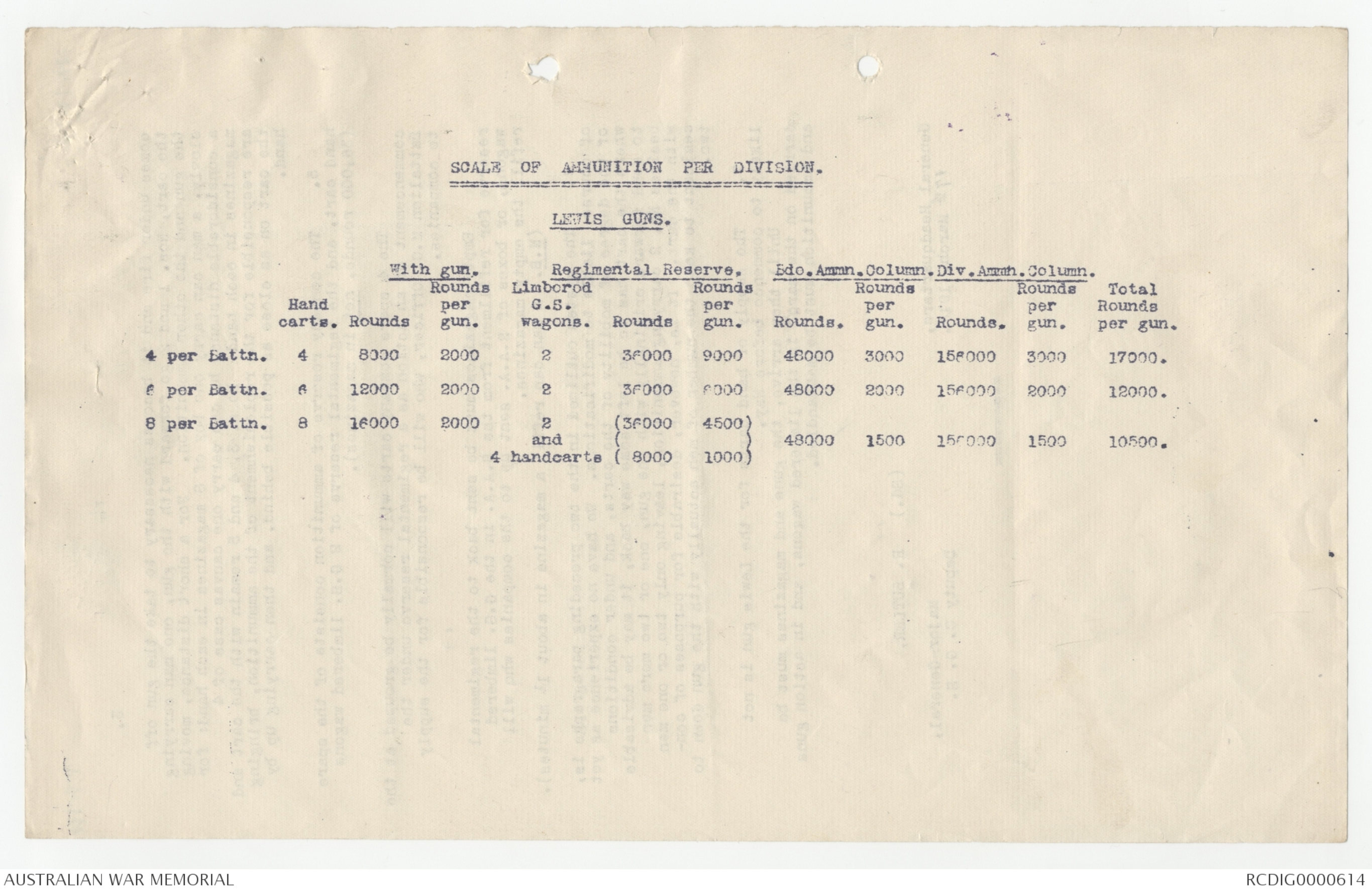
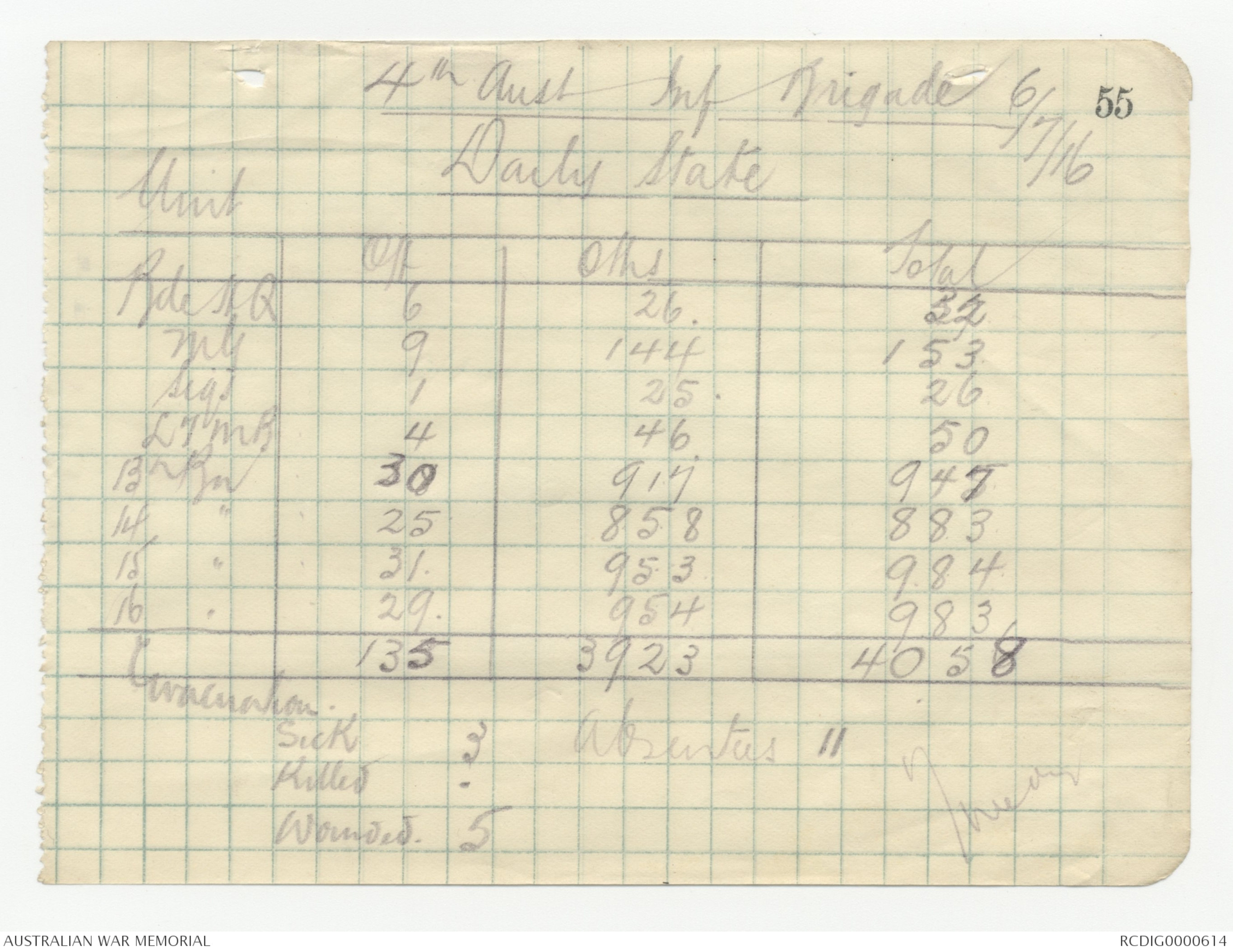
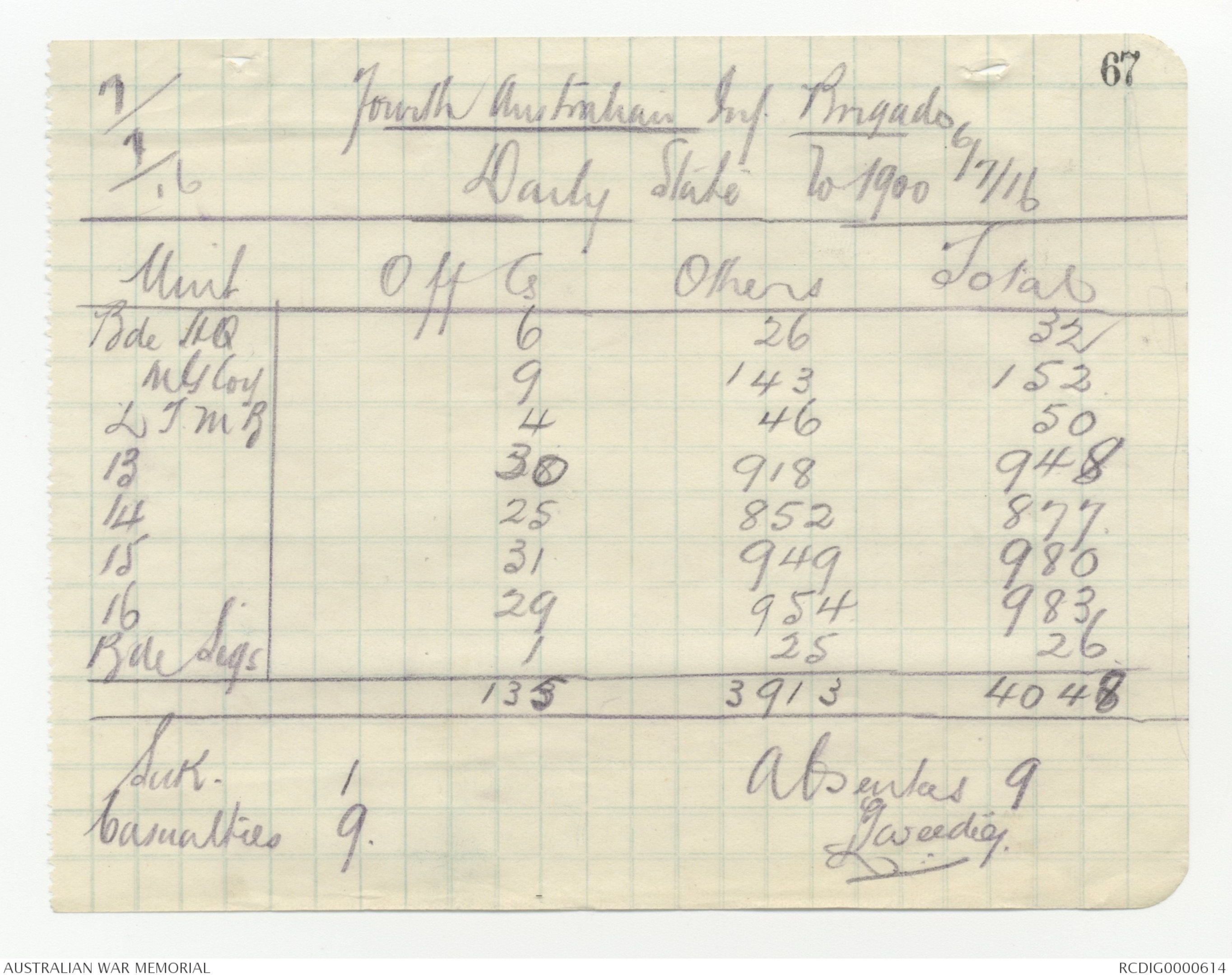
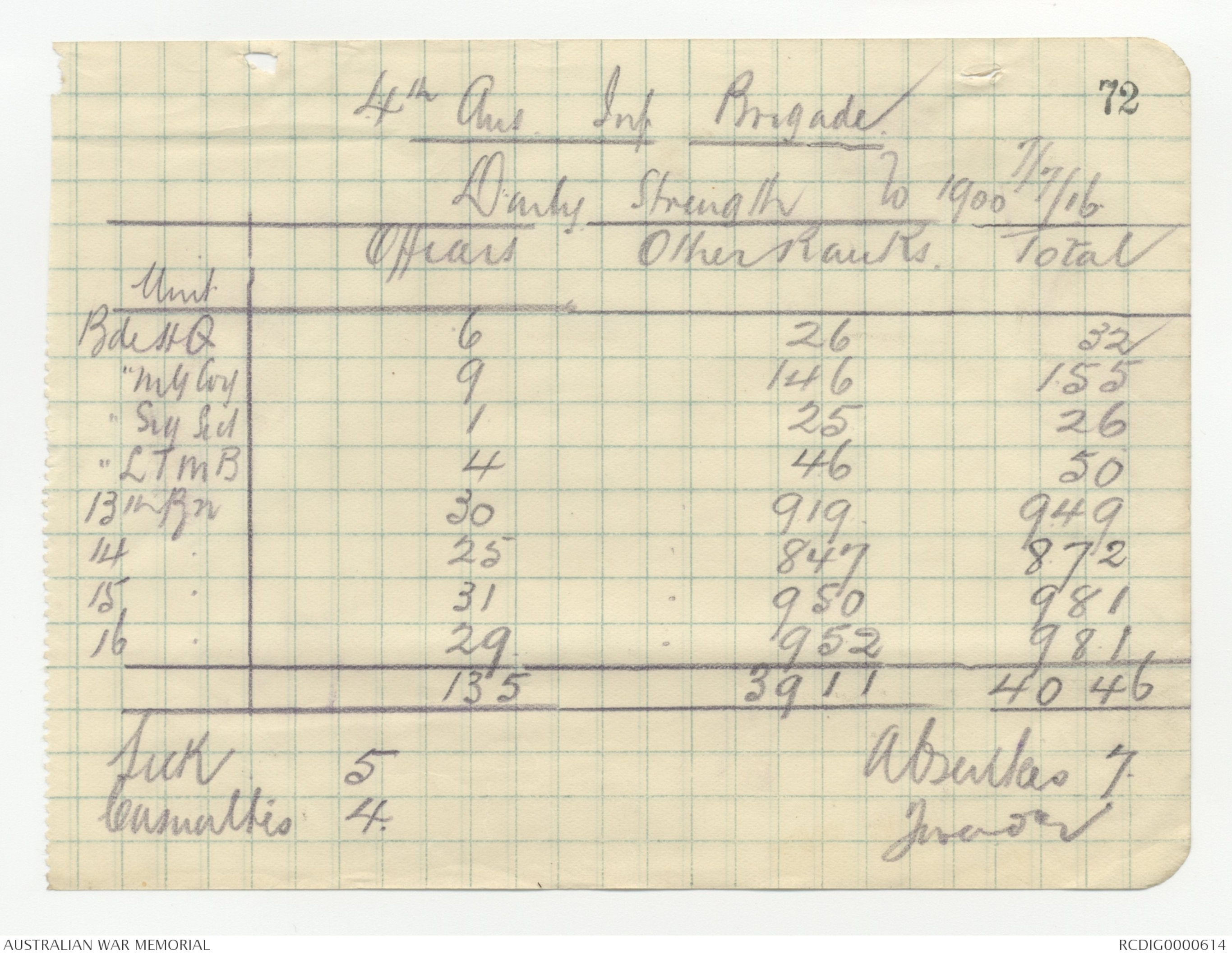
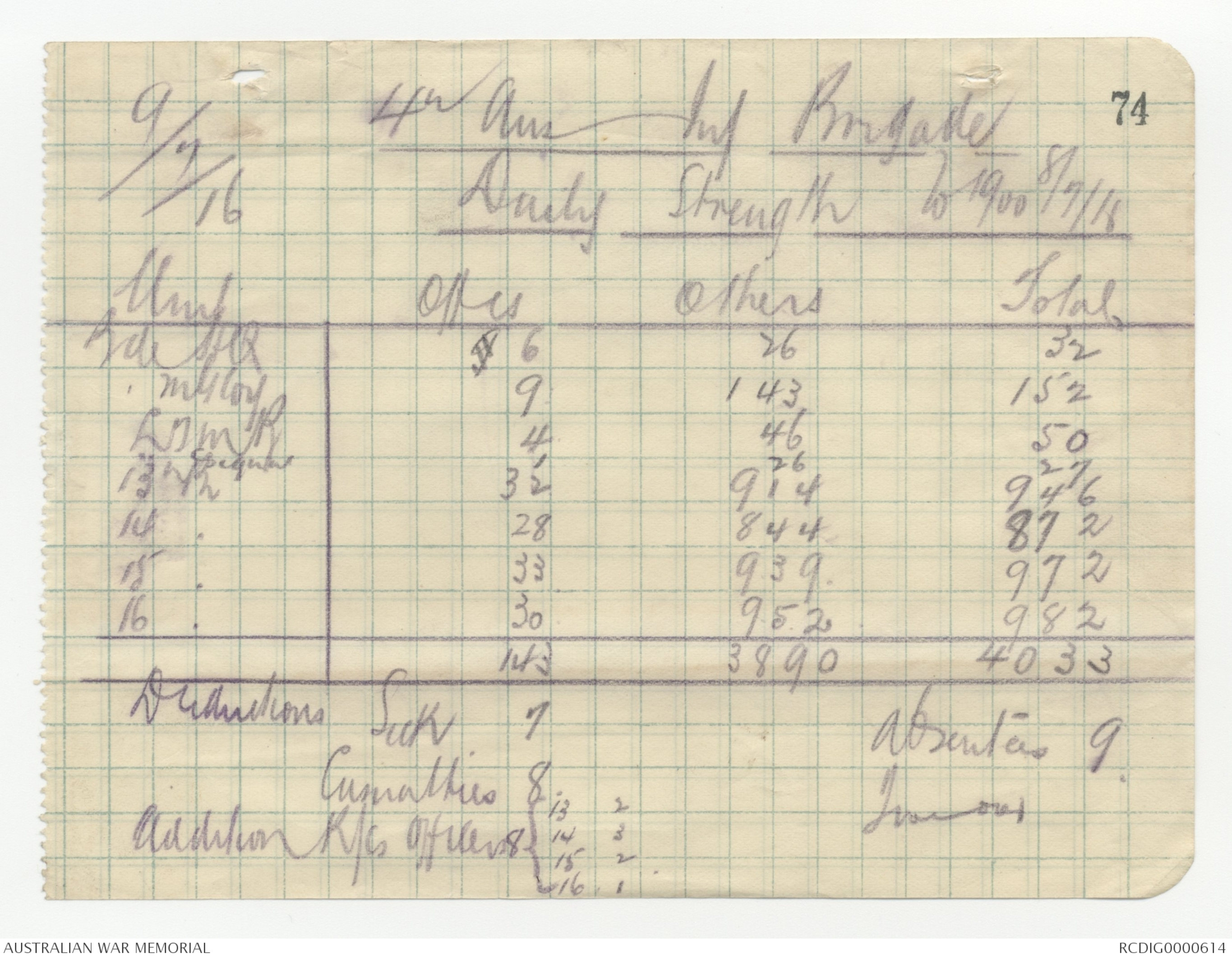
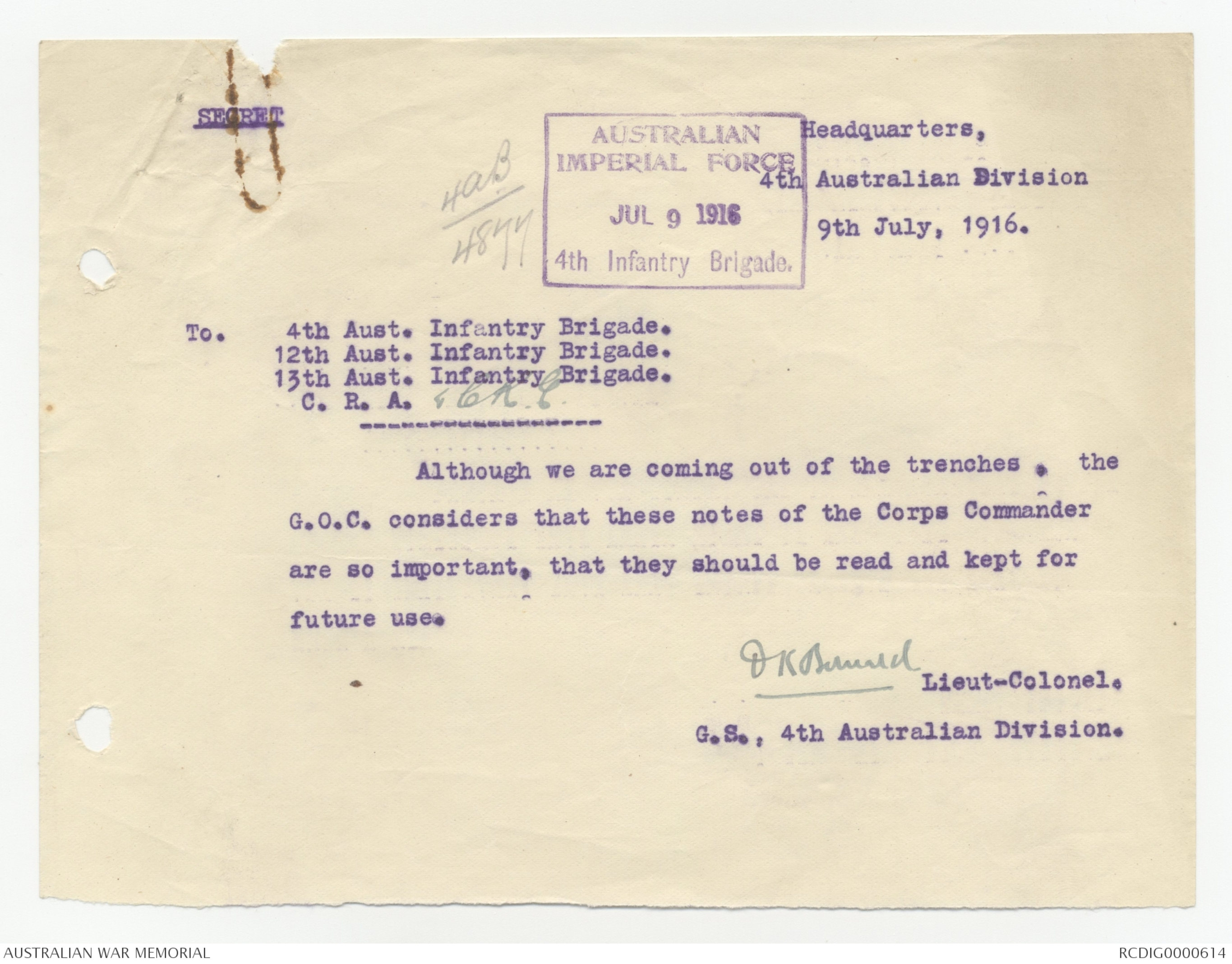
8/7/16
TABLE OF ARTILLERY TASKS
FROM 0 to 0
Time 10.35 to 10.45
Phase 1
Bombardment
|
Battery |
Target |
Estimated |
Remarks |
|
47th |
I.31.d.4.4-1/2 to |
140 H.E. |
X.F.8" Destroying |
|
44th |
I.31.d.1-1/2.2-3/4. to |
140 H.E. |
X.F.8" Destroying |
|
40th |
I.31.c.9-3/4.1. to |
140 H.E. |
X.F.8" Destroying |
| Time 10.45 to 10.56 Phase 2 | |||
|
Battery |
Target |
Estimated |
Remarks |
|
47th |
Same as Phase 1 |
120 T.Shrap |
X.F.10" Sweeping |
|
44th |
I.31.d.1-1/2.2-3/4 to |
60 T.Shrap |
X.F.10" Barrage |
|
44th |
I.31.c.9-3/4.1-1/4 to |
60 T.Shrap |
X.F.10" Barrage |
|
48th |
I.31.d.2-1/2.1-1/2 to |
70 H.E |
X.F.8" Enf: Com: |
|
40th |
Same as Phase 1 |
120 T Shrap |
X.F.10" Sweeping |
|
[*430*] |
|||
| CEASE FIRE 10.55 | |||
| Time 10.30 to 10.35 Diversion | |||
|
Battery |
Target |
Estimated |
Remarks |
|
48th Rt: X |
I.26.d.8.0. |
35 H.E. |
X.F.8" Destroying |
4aB/4846
AUSTRALIAN
IMPERIAL FORCE
JUL 8 1916
4th Infantry Brigade
NOTES ON USE OF LEWIS GUNS IN AN ADVANCE.
1. It must be clearly understood that the Lewis gun cannot
take the place of the machine gun. It is a supplement to and not
a substitute for the machine gun. An automatic rifle (of which
the Lewis gun is a type), though capable of extremely rapid fire,
cannot sustain this fire for long. This necessitates therefore
the use of short bursts of fire as the normal practice.
2. The same general principles apply to Lewis guns as to
machine guns. Flanking fire and surprise are the two conditions
which must be sought for and obtained whenever possible. Owing to
the ease with which they can be concealed, Lewis guns, even more so
than machine guns and much more so than infantry, possess the power
of surprise. They must therefore avoid disclosing their positions
by opening fire without good reason.
3. Owing to its lightness and the small target it offers,
the Lewis gun is of great value in an attack. It is particularly
adapted for providing covering fire from the front during the first
stage of an attack. Lewis gunners, under cover of darkness, smoke
or artillery bombardment, may be able to creep out in front and
establish themselves in shell-holes, ditches, crops, long grass,
etc., where it will be difficult for them to be detected, and where
they will be able to fire on enemy machine gun emplacements, loop-holes
and parapets generally, and so assist the infantry to advance.
It is inadvisable to send forward any Lewis guns with the
first line of attacking infantry, but as soon as the infantry have
got into the enemy's trenches, Lewis guns should be pushed up as
rapidly as possible; they can provide the necessary fire while the
infantry is re-organising and preparing the enemy's captured trench
and will be especially useful on the flanks. They will, in fact,
as far as their nature allows, take the place of machine guns, till
the latter arrive to consolidate the position won.
Special instructions should be given to Lewis gunners to
look for enemy machine guns and concentrate their fire upon them.
4. In open fighting both sides will strive to obtain superiority
of fire as early as possible; the addition of mobile fire
power to the infantry by the possession of Lewis guns will materially
assist them in their task.
Although in an attack from trenches it will usually be
inadvisable to send forward Lewis guns with the leading line, owing
to the short distance to be traversed and to the fact that there are
obstacles such as barbed wire to be passed, in open warfare, where
attacks will probably be made over long distances, and where the
enemy's position is only hastily entrenched, it will be possible to
push forward Lewis guns with the leading line, the gunners moving
and appearing to the enemy as ordinary riflemen. Lewis guns
pushed forward in this way will be able to provide covering fire
for the infantry and will thus help them to advance.
Where ground is suitable, it may sometimes be possible
for Lewis gunners to precede the attacking infantry, and opportunities
to carry out this should be carefully looked for.
An opportunity for pushing forward Lewis guns may also
occur when an advance is held up or a hostile counter attack
develops.
In this way superiority of fire may often be obtained
without incurring the loss incidental to sending up strong reinforcements
to the front line.
5
4th AUSTRALIAN DIVISION
No G 13/5/2
8 JUL, 1916
2.
5. To summarise, Lewis guns will be of great value for
the following purposes:-
(i) To supplement the fire of infantry and machine guns.
(ii) To economise infantry in trench warfare and in
defensive positions.
(iii) Firing from the parapet to command ground which cannot
be swept by machine gun fire.
(iv) To provide covering fire from the front during an attack.
(v) To assist in the consolidation of positions won, and to
cover the re-organisation of the attacking troops.
(vi) For small enterprises, where the weight and visibility
of the machine gun would render the latter unsuitable.
(vii) As a means of reinforcing a line of infantry, with
additional fire power, under circumstances where the
deployment and sending forward of more men would result
in heavy losses.
(viii) To provide a mobile "reserve of fire" in the hands of
company commanders.
It should never be forgotten that the Lewis gun like the
machine gun is a weapon of opportunity, and that surprise is the
chief element of success in its use.
LEWIS GUNS - ORGANISATION AND AMMUNITION SUPPLY.
1. The Lewis detachment of 2 guns, which will be with each
company, when the organisation is complete, will consist of :-
1 N.C.O. and 12 men.
3 handcarts.
2. Two hand carts carry one gun, spare parts wallet and 40
magazines of 47 rounds each. The 40 magazines are in 5 boxes of
8 magazines, and each box contains 2 canvas carriers of 4 magazines
each. There is another compartment in the cart in which 4 loose
magazines can be placed.
Thus each cart has 44 magazines 47 = 2,068 rounds.
The third (spare) cart is similar in design to the others
(i.e. with space for gun, spare parts and magazines) and will carry
40 magazines of 47 rounds each.
(N.B. 64 magazines are allowed for each gun. 44 are carried
in each of the gun carts and 40 in the spare cart: i.e. a
total of 128).
3. The detachment is intended to be organized as follows:-
2 men with each gun in action (Nos. 1 and 2).
3 men responsible for ammunition supply to each gun.
2 men with spare cart (ammunition reserve).
4. The hand cart is extremely mobile and is designed to move
across country. It is intended that the two hand carts with guns
should follow the company as far as possible. When the company
3.
comes under fire and it becomes necessary to take the gun off
the cart, Nos. 1 and 2 go forward with the gun, one man carrying
the gun and the other ammunition. For a short distance, moving
slowly, a man can carry one box of 8 magazines in each hand: for
a considerable distance he can carry one canvas case of 4
magazines in each hand. Nos. 3, 4 and 5 remain with the cart and
are responsible for the replenishment of the ammunition, bringing
the cart on as close as possible behind, and then carrying up by
hand.
5. The company reserve of ammunition consists of the spare
hand cart, and the regimental reserve of 2 G.S. limbered wagons
(36,000 rounds, not in magazines).
The 4 spare company carts will normally be grouped at the
commencement of an action as a regimental reserve unser the
Battalion M.G. Officer, who will be responsible for the supply
to companies.
Empty magazines must be sent back to the regimental
reserve for refillment from the S.A.A. in the G.S. limbered
wagons, or boxes of S.A.A. sent up to the companies who will
refill the empty magazines.
(N.B. A man can refill a magazine in about 1¼ minutes).
6. The system outlined in the two preceding paragraphs is,
of course, liable to modifications. We have no experience as yet
of the degree of mobility of the carts, and under conditions
where the cart has to be left some way back, it may be advisable
to send forward originally with the gun, one or two more men
besides No. 2 carrying ammunition, leaving only two or one men
with the cart. It is, however, desirable for purposes of concealment
to keep the number of men actually with the gun down to
two.
7. The supply of hand carts for the Lewis gun is not
likely to commence before May.
Until they arrive, the guns and magazines must be
carried on the march in the limbered wagons, and in action guns
and ammunition must be manhandled.
(Sd.) R. BUTLER,
Major-General,
Deputy C. G. S.
General Headquarters,
17th March, 1916.
SCALE OF AMMUNITION PER DIVISION
LEWIS GUNS.
| With gun. Regimental Reserve. Bde. Ammn. Column. Div. Ammn. Column. | |||||||||||
|
Hand |
Rounds |
Rounds |
Limbered |
Rounds |
Rounds |
Rounds. |
Rounds |
Rounds. |
Rounds |
Total |
|
|
4 per Battn. |
4 |
8000 |
2000 |
2 |
36000 |
9000 |
48000 |
3000 |
158000 |
3000 |
17000. |
|
6 per Battn. |
6 |
12000 |
2000 |
2 |
36000 |
8000 |
48000 |
2000 |
156000 |
2000 |
12000. |
|
8 per Battn. |
8 |
16000 |
2000 |
2 |
(36000 |
4500) |
|
|
|
|
|
|
|
|
|
|
and |
( |
) |
48000 |
1500 |
15000 |
1500 |
10500. |
|
|
|
|
|
4 handcarts |
(8000 |
1000) |
|
|
|
|
|
55
4th Aust Inf Brigade
|
Unit |
Off |
Oths | Total |
|
Bde HQ |
6 |
26 |
32 |
|
MG |
9 |
144 |
153 |
|
Sigs |
1 |
25 |
26 |
|
LT MB |
4 |
46 |
50 |
|
13th Bn |
30 |
917 |
947 |
|
14 " |
25 |
858 |
883 |
|
15 " |
31 |
953 |
984 |
|
16 " |
29 |
954 |
983 |
|
|
135 |
3923 |
4058 |
Evaluation
Sick 3
Killed -
Wounded. 5
Absentees 11
Tweedie
67
Fourth Australian Inf Brigade
7/7/16
|
Unit |
Offcs |
Others | Total |
|
Bde HQ |
6 |
26 |
32 |
|
MG Coy |
9 |
143 |
152 |
|
LT MB |
4 |
46 |
50 |
|
13 |
30 |
918 |
948 |
|
14 |
25 |
852 |
877 |
|
15 |
31 |
949 |
980 |
|
16 |
29 |
954 |
983 |
|
Bde Sigs |
1 |
25 |
26 |
|
|
135 |
3913 |
4048 |
Sick 1
Casualties 9
Absentees 9
Tweedie
72
4th Aust Inf Brigade
|
Unit |
Officers |
Other Ranks | Total |
|
Bde HQ |
6 |
26 |
32 |
|
MG Coy |
9 |
146 |
155 |
|
Sig Sect |
1 |
25 |
26 |
|
LT MB |
4 |
46 |
50 |
|
13th Bn |
30 |
919 |
949 |
|
14 " |
25 |
847 |
872 |
|
15 " |
31 |
950 |
981 |
|
16 " |
29 |
952 |
981 |
|
|
135 |
3911 |
4046 |
Evaluation
Sick 5
Casualties 4
Absentees 7
Tweedie
74
4th Aust Inf Brigade
9/7/16
|
Unit |
Offcs |
Others | Total |
|
Bde HQ |
6 |
26 |
32 |
|
MG Coy |
9 |
143 |
152 |
|
LT MB |
4 |
46 |
50 |
|
Signalls |
1 |
26 |
27 |
|
13th Bn |
32 |
914 |
946 |
|
14 " |
28 |
844 |
872 |
|
15 " |
33 |
939 |
972 |
|
16 " |
30 |
952 |
982 |
|
|
143 |
3890 |
4033 |
Deductions
Sick 7
Casualties 8
Addition R/G Officers 8 {13 2
{14 3
{15 2
{16 1
Absentees 9
Tweedie
SECRET
4aB/4877
AUSTRALIAN
IMPERIAL FORCE
JUL 9 1916
4th Infantry Brigade.
Headquarters,
4th Australian Division
9th July, 1916.
To. 4th. Aust Infantry Brigade.
12th. Aust Infantry Brigade.
13th. Aust Infantry Brigade.
C.R.A. & C R.G.
Although we are coming out of the trenches. the
G.O.C. considers that these notes of the Corps Commander
are so important, that they should be read and kept for
future use.
{{D K Donald?]]
Lieut-Colonel.
G.S., 4th Australian Division.
 Sam scott
Sam scottThis transcription item is now locked to you for editing. To release the lock either Save your changes or Cancel.
This lock will be automatically released after 60 minutes of inactivity.